We learned it in the previous Sermon. It's CHIM. Of course, if you were reading the Lessons in-game, as you played through Morrowind, you might not have read Sermon 12 by this point. Such are the issues presented by a randomized item list.
I tend to swing back and forth on this line, as well as similar ones. There's two interpretations that occur to me, and I like both of them, so it's hard to choose.
The first is that "man" actually refers to the Mannish races specifically. It can therefore be assumed that the sentence is reminding the reader that Men are the "wandering Ehlnofey," those that descended not from et'Ada, like the Merrish races, but rather from the product of Lorkhan and the other "gift-limb" Aedra. Mannish races are a product of the linear nature of Mundus, and therefore are called a myth because they are a legend told by the Aedra that gifted their essence. And, like a myth, they are not necessarily the truth.
The second interpretation requires the consideration that "man" can mean all mortals, not just the Mannish races, such as Nords or Redguards. If this is the case, then the "temporal myth" is that all mortals are a myth of time, a product of the winding of Akatosh and the creation of linear time. Mortals become a story, or legend, or myth, of time.
With this interpretation, the line is a reminder that mortality is a product of the Will of Lorkhan, and that all beings, Men and Mer alike, must pass from Mundus.
Considering the content of this Sermon, I suspect this is the most appropriate interpretation.
We're going to be dealing with some fairly abstract symbolism here, so I'll do my best to augment things with images whenever possible. But first let's talk about the symbol of the cross.
The cross has been used quite a lot by quite a few mystical practices. Christians are familiar with the symbol of the crucifix upon which Jesus Christ died, but the symbol's use in the 36 Lessons has less to do with that symbol than others.
In Astrology, the "Cross of Matter" represents (as far as I can tell) the "map" of the heavens, which is to say the area that celestial bodies travel over during the year. This cross is composed of two axis, the course of objects between Noon and Midnight (the Y axis) and movement from West to East (the X axis).
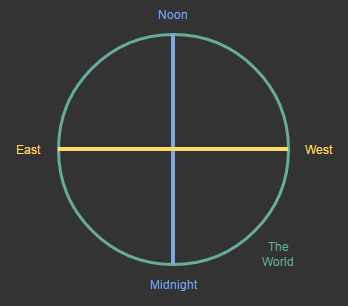
The cross of matter therefore represents the physical world, or Earth, and it is used on astrological signs that have connections with the Earth, such as Mercury, Venus, Pluto, etc.
The somewhat obvious connection to the four cardinal directions has certainly occurred on you by now, but several other crosses repeat this concept, such as the Lauburu Cross.
These two symbolic systems, the Cross of Matter and the Cardinal Cross, equate the shape of the cross with the physical realm, and in the 36 Lessons it's possible that the Magical Cross Vivec mentions might represent the realm of Mundus or Nirn or even only Tamriel itself, if there is any separation to be made. It's a pretty solid metaphor.
But an alternate interpretation can be found in the myriad forms of the Sun Cross, which is repeated by numerous other symbols including the swastika. The basic principle behind the Sun Cross is to represent radiating energy, as one would expect with something called the "Sun" Cross. The four limbs of the cross represent the four cardinal directions, which is to say all directions. They point outward from the center, which is the center point and the root of this radiating power.
This alternate interpretation of infinite radiating energy can be conceptually linked to the interpretation of the all-encompassing physical realm if you consider the connections between the Aurbic Wheel and the creation of Nirn. For example, the radiating lines could be the Gift-Limbs of the Aedra. A circular outline could be the borders of the finite Mundian realm.
The "worth" of mortals changes depending on which culture you're talking about. The Altmer would probably suggest that mortality is worth nothing, being a curse inflicted by Lorkhan and upheld by the races of Men. But the Dunmer would suggest otherwise, and certainly Vivec would provide specifics. I strongly suspect in this case that the "worth" of mortals is their invaluable role in creating an escape from the Aurbis by creating the New Man, the Amaranth.
This is the unfortunate truth of the Aurbis: many men must die and many souls must be sacrificed before the worth of mortals can be actualized. Therefore, if the Magical Cross is symbolic of the integration of the sacrifice of mortals in the interest of their eventual liberation, the cross itself suddenly becomes strongly reminiscent of the Christian crucifix, which represents the sacrifice of Jesus Christ in the interest of the liberation of mankind from sin.
So in the end it's easiest to say that the Magical Cross as mentioned in the 36 Lessons is a symbol of the "purpose" of Mundus: the liberation of all those who suffer under the cyclical eternal dream of the Godhead.
Now we're launching head-first into something I like to call "mystical geometry." One could describe Mathematics as the science of finding connections between numbers, and similar things could be said for the science of geometric relationships. But in early civilizations there was no disconnection between geometry and the divine. Taoists, for example, have been examining the concept of the magic square in varying levels of complexity since perhaps as early as 650 BC.
Hermetic Philosophers like John Dee made no distinction between mathematics and religion, since many of his peers felt that they were uncovering the secret and holy theories and machines through which the will of God is manifest. John Dee himself made a system of symbols out of what may have been nothing more than symbolic shorthand employed by astrologers and alchemists, but John Dee's mystical use of geometry continues to influence hermetic philosophers long centuries after his death. This is due in part to Dee's consistent and logical use of geometric relationships, and that same style of evolving geometry is employed by Vivec in this Sermon.
When they read this, most people immediately see something like this in their heads:
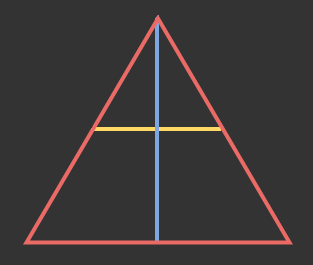
But I think there are a few other ways to go with this, and while they might not work with the rest of this Sermon, they're still worth discussing.
This is the organization of ALMSIVI, the Tribunal cult in Morrowind with which the Player can interact. Note that it is called a "House," despite or in spite of the warnings about the dangers of Houses in Sermon 10. Houses are double-edged swords. They help provide structure to otherwise chaotic notions, but they become destructive when they serve to divide the very things they try to defend. The Triune House is certainly guilty of this, considering the state of Morrowind in 3E 427, where we find a great deal of conflict between the Ashlanders and the "House Dunmer" that the Tribunal only exacerbates.
It's easy to see how the previous example can be divided into corners, but what if we instead surround the cross with four triangles? At this point it begins to more closely resemble the Cross of Matter; a cross surrounded by a shape that represents the physical edges of the world's body.

Or, if you like, it could be a three-dimensional shape, like a pyramid:
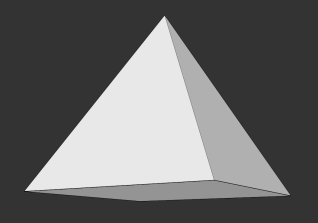
Why a pyramid? Egyptian pyramids are thought to be references to the Benben, the primordial mound of mud from which all of existence originated. I've already touched on the mystical relationship between earth (the substance, not the planet), Nirn, and mortal life, of course. And this relationship reappears several other times in Elder Scrolls lore, though I can only think of Hrol's Hillock at the moment. And there are some theologists who speculate that the shape of the pyramid infers a transition from the base (earth, and mortality) to the top (sky, and divinity), which confers the shape of the pyramid as a method of ascension to divinity. And that is, of course, exactly what ALMSIVI is.
But if we have to pick just one diagram, I think we should choose our first image and stick with it:

That the Triune House is bordered by the four troublesome Daedra could mean that Vivec, Sotha Sil, and Almalexia are all directly threatened by the four Princes, and I'm sure that they are. But it could also be a metaphor for the constant threat of destruction from a myriad of enemies.
Here's an interesting thing: why aren't these names separated by commas? Because it is not a list of names, but rather the name of the Four Corners of the House of Troubles, a seven syllable spell. It's a single name assigned to a single entity, in exactly the same way that AYEM AE SEHTI AE VEHK denotes the combined spirits of Almalexia, Vivec, and Sotha Sil.
Rotating the triangle produces an inverted triangle:
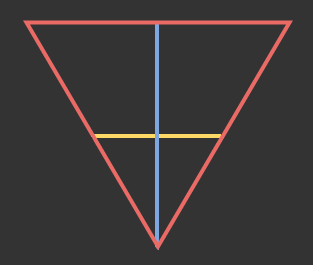
It's a downward-pointing arrow, but also an inverted triangle. I strongly suspect this represents the mythic "structure" of ALMSIVI, beginning first at the base with the piercing of the Heart of Lorkhan and spreading until it reaches the horizon, which represents the future.
This phrase, or a variation of it, doesn't appear in the 36 Lessons except in the final Sermon, which we will cover when we get to it. It is, however, another way to consider the symbolism of the Beginning Place as a location that marks the life and efforts of Lorkhan, who was betrayed by his fellow et'Ada. But for the moment, consider that this could also be a reference to a terrible falsehood committed in the Beginning Place, where ALMSIVI was forged in the fire of Lorkhan's Heart.
I think this is a good way to describe Almalexia, Vivec, and Sotha Sil when they first activated the Heart of Lorkhan. Through Sotha Sil's research they discovered how to manipulate the energies of the Heart in just such a way that it creates a tiny "dragon break," a moment where time becomes non-linear. This moment, when Akatosh, the God of Time becomes "unwound," a mortal of sufficient magical strength can make any assertion become reality. In effect, Vivec "lies" and states that the three Tribunal are Gods. When time snaps back into place, the lie becomes truth, and Akatosh and his minions stitch history back together again so that this new truth can become possible.
Thus Vivec becomes an egg, and an image, and a seven syllable spell. Because, for a span of time, their will was irrefutable.
But the efforts of Akatosh and his minions are often only enough to barely support this new truth. Consequently most of Morrowind, and the rest of Tamriel, are fully aware that Ayem, Seht, and Vehk were once mortals. The story created by the 36 Lessons may have brought the Tribunal their power, even possibly change reality itself, but it cannot change history or the memory of history. That memory is the domain of another entity altogether and it is beyond the influence even of ALMSIVI, though evidence exists that Sotha Sil may have discovered its secret before his death.
Here we see Vivec experiencing another premonition of the Amaranth, the New Man, "above" all because the Amaranth is the first true God of Nirn.
I have to watch what I write here, because I'm saving a lot of the Amaranth's lore for Sermon 35. I have to do it this way because otherwise, by the time we get to that Sermon, I'll have covered everything and I won't have anything left to write.
Again, the Amaranth. The New Man.
Probably we're talking about the concept also called the Promise of the PSJJJJ, which we'll detail later in Sermon 25 in great detail.
I'm still not entirely sure what shape we're supposed to be looking at here. But a general sense of intuition leads me to believe it might resemble a hexagram, the Star of David, known in Christian circles as the Star of Creation.
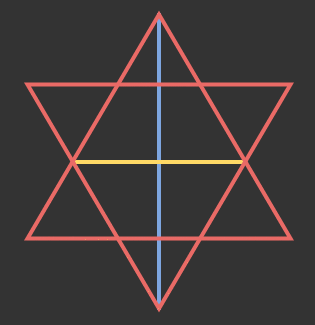
Alternatively it could also be the symbol of the four combined elements, the double-hexagram, which very closely resembles our diagram, including the cross at the center.
And if you want to dive straight into the deep end, you could theorize that the shape now resembles the Unicursal Hexagram. An adapted version of this configuration is an important symbol in Thelema, and encompasses (roughly) the intertwining of the microcosmic and macrocosmic forces. Similar to the Egyptian ankh, this symbol represents the unity of the divine and the mortal.
And let's not forget Sermon Five, where we discover that the motif of "unfolding" can mean an increase in complexity; it's an evolution of nature. Therefore, we are encouraged to visualize this primal shape transforming into something more complex, more nuanced. And in so doing, it evolves into a new form.
Okay, great. But why a star? This returns us to Gnostic philosophy, and a concept that is perhaps most clearly explained by Aleister Crowley's Thelemic beliefs. That many of the stars above Nirn are Gods is not a figurative concept. But in the real world, many religions and cultures share the same view, assigning names and attributes to many of the brightest stars in the night sky. In many Gnostic philosophies, the concept of a mortal's "inner star" repeats this concept. I'm not really qualified to speak authoritatively on this, but to me the inner star seems to be an echo of the familiar Western concept that "God is everywhere," a logical iteration of the infinite divine nature.
In broad strokes, an individual's star is the presence of God that lies in every mortal. It is unique in nature, just as God itself is infinite in variation. Fractal-like in its self-similarity.
True, it's Ayem's. But Vivec's nature as Mastery and the combining force, not to mention hir knowledge of the inner divine nature, means ze has some claim to them.
A star that ascends is a soul that experiences apotheosis, a mortal that becomes a God.
In ancient Egypt, the wasp or hornet was considered a symbol of fertility. This becomes relevant in the next few comments, so just keep "fertility" in mind.
This line figures prominently in "The Second Coming," a poem by famous 20th-century Irish poem W. B. Yeats, reproduced here for your convenience:
Turning and turning in the widening gyre
The falcon cannot hear the falconer;
Things fall apart; the centre cannot hold;
Mere anarchy is loosed upon the world,
The blood-dimmed tide is loosed, and everywhere
The ceremony of innocence is drowned;
The best lack all conviction, while the worst
Are full of passionate intensity.Surely some revelation is at hand;
Surely the Second Coming is at hand.
The Second Coming! Hardly are those words out
When a vast image out of Spiritus Mundi
Troubles my sight: somewhere in sands of the desert
A shape with lion body and the head of a man,
A gaze blank and pitiless as the sun,
Is moving its slow thighs, while all about it
Reel shadows of the indignant desert birds.
The darkness drops again; but now I know
That twenty centuries of stony sleep
Were vexed to nightmare by a rocking cradle,
And what rough beast, its hour come round at last,
Slouches towards Bethlehem to be born?
A brief analysis of this poem is that it uses Christian imagery to discuss a coming apocalypse. And the coming apocalypse is certainly something that weighs heavily on Vivec's mind. We've already seen hir deal with this prescient image in earlier Sermons, hinted at by the importance of hir birth in Sermon Four, a mention of the End of Days in Sermon Six, and so on. But now Vivec begins to sketch the outlines of hir catastrophic visions with metaphor.
When do you think it occurred to Vivec that doom lay on the horizon? At the moment of hir apotheosis, or some time after? Was it all at once, in one terrifying realization? Or over time, in a series of visions?
Or is it more fearsome to consider the possibility that Vivec might have had this knowledge before ze became a God, brought to hir by hir inner third eye?
Consider a geometric shape, like a triangle. It has three lines, and where those lines end they meet and form three points. Almost all geometry can be expressed by finite lines and the points where they meet.
But if a shape loses all the lines and points that define it, it becomes a void. It is an absence of a shape, and therefore, like a void, it is a vacuum, and constantly seeks something to fill it.
If you haven't already guessed where I'm going with this, tune in again in Sermon 25, where we discuss the Promise of the PSJJJJ. I mean, otherwise there's not much to talk about during that Sermon, which is mostly poetry.
We'll get really deep into the symbolism of the Sword in Sermon 23, since that's the Scripture of the Sword, but for the moment consider that the Sword, like the symbol of the Magical Cross, represents the nature and the purpose of Mundus. And that purpose is, of course, change. Though it might be confused for destruction, the two are the same, since destruction is simply the transformation of one state into another state.
I have to stop myself here. I can't give the whole thing away. Not just yet.
A lot of people (including myself, once) are convinced that Vivec is suggesting that ze must be defeated by the Nerevarine. But I would suggest a more subtle interpretation.
I think Vivec is speaking of the eventual dissolution of ALMSIVI and the Tribunal organization from Morrowind's structure. Ze is predicting hir eventual retirement from office, when ze leaves Morrowind late in the 3rd Era to visit the Emperor of Cyrodiil, who by that point will be near death and has many questions about the past, as well as the nature of the universe and his role in it.
Vivec leaves Morrowind for hir own interests, but also because hir people no longer worship hir as feverishly as they once did. Perhaps this is due to Vivec's waning power, or because the Nerevarine has become Morrowind's new Ruling King. Or perhaps both. Or neither.
But Vivec has to leave. Ze must be removed because ze is part of a system, part of a wheel, and the nature of these structures is that they will eventually fall apart. They must fall apart so that they can be rebuilt into a better shape.
This could be a reference to the reincarnations of Nerevar that have come before the events of Morrowind late in the 3rd Era. I suppose your opinion on whether or not the Player's character in Morrowind is the final reincarnation of Nerevar.
Not every Nerevarine that has come before has fallen to Vivec. Many died in battle against a wide selection of foes. But Vivec's teachings and the Tribunal church certainly convinced Ane Teria that she was not a Nerevarine until late in her life.
It seems to me that this is probably a play on words. "The last" as in both "previous" and "final." If so, I'd conjecture that Vivec considers hirself the defender of hir predecessors, the Anticipations; Boethiah, Mephala, and Azura. But that ze considers hirself to be "the final" probably means that Vivec did not expect another centralized dogma to exist after the dissolution of the Tribunal.
Sure, this could refer to the fact that the Tribunal have been "draining" the Heart of Lorkhan over the years, but I doubt it. First, because it doesn't seem to follow the flow of thought in this paragraph, and also because I just don't think the Heart of Lorkhan can be drained at all. It's a God's heart, you know? Not a vending machine.
Instead, I'd suggest that this phrase refers back to the concept of the center, devoid of lines and points, becoming a receptacle, or a womb, and that brings us home to the fertility motif we mentioned back when we were discussing Egyptian hornets.
The heart in this metaphor refers not specifically to an organ, but rather to a center that marks the beginning of the formation of a structure and is also required for the continuing existence of that same structure. For example, consider the soil in which a seed is planted. The seed becomes a tree, but the tree will die if the soil is removed. Without the soil, the tree can neither grow nor survive.
Vivec will refer to hirself as "the sword" several times in the Lessons as ze takes on the responsibility for implementing change in the world. Unfortunately for hir, this responsibility also requires that ze be the impetus of change within ALMSIVI as well.
Again, even if ze does not yet understand the specifics, Vivec flirts with motifs of the apocalypse.
I strongly suspect this refers to the arrangement Lorkhan made with his fellow et'Ada who later became the Aedra. According to the Dunmer, or at least Vivec, the Aedra helped form Mundus in order to create conditions in which the Amaranth can be born. The "compromise" is that the Aedra, including Lorkhan, would be unable to take part in this new dream.
We've flirted with it before, back in Sermon 10 when we were talking about the Phosphorescent Mirror, but as a quick reminder:
The gist of this metaphor is that the memory of things are sometimes lost, or forgotten. If memory is water, or a sea, then lost memories sink beneath the surface and are obscured from view, unable to be found again. Unlike a Drowned Lamp, to be filled with black sea means this compromise will not shine on in memory.
In this case, Vivec is expressing concern that Lorkhan's purpose in building Mundus might be lost if the Tribunal does not remind people of it. If the mortals of Nirn are not reminded that Lorkhan designed their realm so that they might free themselves from the Godhead's dream, all their incalculable effort might be for nothing.
The location of the Sharmat is both literal and metaphorical. After his initial death at the hands of Nerevar, Voryn Dagoth's spirit dissipated into the mystical aura of Lorkhan's heart, and the two became inexorably linked. Voryn Dagoth's spirit slumbered at the center of Red Mountain, the Beginning Place, the center of all of Velothi culture and the Dunmer homeland. But the Heart of Lorkhan is also the Heart of Mundus in that it is the centerpoint of the Aedra that gave his life so that Nirn may live, and therefore metaphysically became Nirn itself.
White Gold Tower might be the center of Tamriel. Adamantine Tower might be the first point of linearity in Mundus. But Nirn only has one heart.
Though we are familiar with the visual of the Aurbis as a great wheel, Mundus has one as well, and I would assert that Red Mountain is its center. That the Thalmor call it a Tower is therefore not coincidental.
Saying that Voryn Dagoth "sleeps" is another way of explaining his state of existence before his "awakening" just before the Morrowind game begins. But Dagoth Ur's sleep also means that he was dreaming while he slept. We'll analyze that concept more in Sermon 15, the third of Vivec's three lessons.
We touched briefly on this in Sermon 11. The Sharmat believes that there is no difference between the dream state he is experiencing and the real world of Nirn. He believes that Nirn, which is a world of "reference" or motifs, is real. The Sharmat does not understand the existence of the Godhead, or his place in the true nature of the Aurbis.
Dagoth Ur does not understand that he is actually part of a dream, and therefore part of the unreality of the Godhead's hallucination. He thinks that the dream he has experienced and continues to experience is real, and so is Nirn. He may not even understand that he is dreaming, but he is.
In fact, there are only a few functional differences between the state in which the Sharmat dwells and CHIM, the dream-like manipulation of the Godhead's illusion. If attaining the state of CHIM is like lucid dreaming, to attain it we must first begin to dream, and this is what the Sharmat does, but without first understanding the true nature of the dream he is controlling.
If this seems confusing, wait until we get to Sermon 15. I'll break the whole thing down in great detail, since it is the Sharmat's Sermon.
The problem with confusing a dream with reality is that it leads to irresponsible and damaging behavior, which we will discuss in detail in Sermon 15 when we talk about the Blight.
To gain control of the dream is to gain power over it, but the means with which you gain that control is critical.
In a way, this is how Dagoth Ur controls reality from within the Center. He manipulates the Dream by circumventing its nature, by approaching it with his eyes closed, unable or unwilling to fully visualize its true nature. Lorkhan understood the true nature of reality, but why doesn't Dagoth Ur?
Compared to CHIM, Dagoth Ur's magic has absolutely no game. His technique is barbed in venom because it will cause his own destruction. The tale of the Sharmat is tragic for many reasons, but one of them is that his own power is destroying the very thing he loves.
And again we return to the mercy seat. Vivec reminds us that a requirement to having true power is to be compassionate, to serve those that you govern. Dagoth Ur does not understand this because he cannot discern reality from dream, and therefore he believes that he is a King that should be adored and absolute.
Reddit user Cheydin pointed out that the "mercy seat" is a symbol shared in Christianity, mentioned first in the Old Testament as a literal golden throne upon which God might descend to the surface of the Earth. That throne enabled a mortal sinner to approach God, even though those very sins would normally separate mortal from divine.
Christians, however, refer to Jesus himself as a "mercy seat" because his sacrifice enables all mortals who were once sinners to regain the mercy of their Lord.
It's easy to see how the secret of swords is Vivec's mercy seat and hir throne: by refinement through death the Velothi may cleanse themselves of sin and approach divinity.
A psychopomp is an entity that guards and escorts souls into the afterlife. It is a powerful entity, but it is also caring and gentle.
But Carl Jung, who was a major influence on Hermetic practice and the 36 Lessons, suggested a theory that a mediator existed between the conscious and unconscious realms. He called this mediator a Psychopomp, and suggested that it served as a teacher, a mediator between divine internal knowledge and the mortal student.
This is why Vivec describes hirself as the "voice" of ALMSIVI. Ze exists to teach hir students the divine truth, the secrets of the Aurbis and of all reality.
However, the Psychopomp requires service in return. Usually, it asks for protection while it confers this divine knowledge and, in a way, so does Vivec. This is perhaps the reason why Vivec does not consider hirself a prophet in the traditional sense, because the prophet's message is one of warning, offered free to all. Vivec intends to train Veloth, preparing it for the oncoming storm.
Vivec's going to go on at length in the Scripture of the Sword (Sermon 23) about removing weeds from the garden. It has a lot to do with destruction as improvement and we'll get to that later, in time.
So now Vivec creates a metaphor of the Wheel that places Veloth at the center, and in so doing, infers that Veloth is every bit as temporary and mortal as anything else on Nirn. It's a hard pill to swallow, but it's true: everything ends.
This is a little sneak-preview of the Main Quest in Morrowind. At first, when the Player declares himself a Nerevarine, the Tribunal Temple will respond by declaring him a liar, a dangerous heretic and a false Nerevarine. Eventually, however, as the plot proceeds, Vivec will become convinced that you really are the reincarnation of Nerevar and request an audience. Vivec will ask you to approach hir as a friend, although it's up to the Player to decide how to handle the relationship.
GHARTOK PADHOME GHARTOK PADHOME
At this point in time, Vivec does not know what form the Nerevarine will take. But ze does know that the Nerevarine will have to become as ze is: a state of being beyond mere sexuality and biology. A mutable form, adaptive, unpredictable, and powerful.
Yeah, that's the thing about being a King: you can't share your power. Anyway, we've already discussed this at length in Sermon 11, so I'll leave it at that.
Sure, on one hand this could be literal. Vivec's head is with Nerevar, hir body is with Molag Bal. But don't you think there's probably more going on here?
Is it possible that Vivec is still as ze has been, a star with its penumbra broken off? In this case, hir head is literally "broken off."
The completion of Vivec doesn't happen until the very end of Sermon 17. Until then, ze is only a space devoid of shape, because nothing cannot be the center without a structure to map its borders.
In Sermon 11, Vivec took great care to explain to the Hortator the various reasons why all things must end, in particular governments and other political structures, and in this Sermon ze tells us that the Tribunal must end as well. But to be more specific, ze speaks of how Vivec hirself will play a role in this destruction without sacrificing hir role as the facilitator of the Tribunal political machine.
Of course, this is all while trickling little details about the end of the world. I suspect this is because Vivec hirself did not comprehend this disaster all at once, but I don't really have anything to back that up. Just a hunch.
Also, can I just mention that this, the second Lesson of ruling kings, was delivered to the Hortator by Vivec's severed head? That's a hell of a way to get taught something.
Lesson Thirteen
Synopsis | Narration
These were the days of Resdaynia, when Chimer and Dwemer lived under the benevolent rule of the ALMSIVI and their champion the Hortator. When the gods of Veloth would retreat unto their own, to mold the cosmos and other matters, the Hortator would at times become confused. Vivec would always be there to advise him, and this is the second of the three lessons of ruling kings:
"The secret syllable of royalty is this: (You must learn this elsewhere.)
'The temporal myth is man.
'The magical cross is an integration of the worth of mortals at the expense of their spirits. Surround it with the triangle and you begin to see the Triune house. It becomes divided into corners, which are ruled by our brethren, the Four Corners: BAL DAGON MALAC SHEOG. Rotate the triangle and you pierce the heart of the Beginning Place, the foul lie, the testament of the irrefutable-for-a-span. Above them all is the horizon where only one stands, though no one stands there yet. It is proof of the new. It is the promise of the wise. Unfold the whole and what you have is a star, which is not my domain, but not entirely outside my judgment. The grand design takes flight; it is transformed not only into a star but a hornet. The center cannot hold. It becomes devoid of lines and points. It becomes devoid of anything and so becomes a receptacle. This is its usefulness at the end. This is its promise.
'The sword is the cross and ALMSIVI is the Triune house around it. If there is to be an end I must be removed. The ruling king must know this, and I will test him. I will murder him time and again until he knows this. I am the defender of the last and the last. To remove me is to refill the heart that lay dormant at the center that cannot hold. I am the sword, Ayem the star, Seht the mechanism that allows the transformation of the world. Ours is the duty to keep the compromise from being filled with black sea.
'The Sharmat sleeps at the center. He cannot bear to see it removed, the world of reference. This is the folly of the false dreamer. This is the amnesia of dream, or its power, or its circumvention. This is the weaker magic and it is barbed in venom.
'This is why I say the secret to swords is the mercy seat. It is my throne. I am become the voice of ALMSIVI. The world will know me more than my sister and brother. I am the psychopomp. I am the killer of the weeds of Veloth. Veloth is the center that cannot hold. Ayem is the plot. Seht is the ending. I am the enigma that must be removed. These are why my words are armed to the teeth.
'The ruling king is to stand against me and then before me. He is to learn from my punishment. I will mark him to know. He is to come as male or female. I am the form he must acquire.
'Because a ruling king that sees in another his equivalent rules nothing."
This is what was said to the Hortator when Vivec was not whole.
The ending of the words is ALMSIVI.
In this Sermon, Vivec explains with more specificity how endings happen, and why the ending is so unavoidable. But to our astonishment, ze even details the ways and means of the Tribunal's inevitable demise, and hir own role in it.
In Morrowind, Sermon 13 grants a bonus to the Athletics skill. It is worth 200 Septims and weighs 3 units. A copy can be found in the Falas Ancestral Tomb. Another can be purchased from Vasesius Viciulus, a trader in Molag Mar.
Sermon 29 names this Sermon "The Serpent." Its number is 36, which references the word "to."